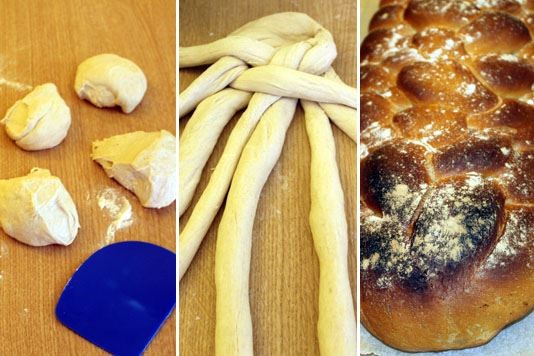Keen baker Elizabeth Ryan shows us how to make Paul Hollywood's famous eight-strand plaited loaf, step by step.
Having witnessed Paul Hollywood’s blasé attitude to baking bread, I decided to give his scary eight-strand plaited loaf a go. And, apart from my loaf getting slightly caught in the oven, I have to say I’m quite pleased with my first attempt.
Let me guide you through making your own, starting with the all-important ingredients. I've included an image of each step in the plait-making process to give you a helping hand.
What you will need
600g strong white bread flour, plus extra for dusting
12g salt
12g instant yeast
35g unsalted butter, softened
400ml cool water
Olive oil for kneading
Step by step
 Tip the flour into a large mixing bowl. Add the salt to one side and the yeast to the other, which is important because the salt can retard the yeast. Add the butter and three-quarters of the water. Turn the mixture around with your fingers using a ‘claw hand’.
Tip the flour into a large mixing bowl. Add the salt to one side and the yeast to the other, which is important because the salt can retard the yeast. Add the butter and three-quarters of the water. Turn the mixture around with your fingers using a ‘claw hand’.
Add the remainder of the water, small amounts at a time, until you’ve picked up all the dry ingredients in the bowl. You might not need to add all of the water, or that you may need to add more. The key thing to remember is that you want a soft dough, not a soggy one. Keep mixing until a rough dough has formed.
Coat the work surface in a little bit of olive oil, then tip the dough out and begin to knead. Knead continuously for 5-10 minutes, until the dough feels smooth and silky.
Lightly oil your mixing bowl and pop the dough back in. Cover with a tea towel and leave in your kitchen to rise until it’s doubled in size. This should take at least one hour, but could take two or three depending on the natural temperature of your kitchen.
Line a baking tray with parchment or silicone paper. Once the dough has risen, scrape it out onto a lightly floured surface. Roll it into a long oblong to knock the air out of it.
Divide the dough into eight equal pieces. Roll each out into a long sausage, around 40cm in length. Try to use the whole length of your hand when you are rolling.
Lay the rolls side by side onto a lightly floured surface and secure them all together at the top by tacking them down to the worktop. It should form an octopus shape.
Now it’s time to plait the dough. As the strands are laid out in front of you, number them from 1-8. Every time you move a strand, the numbers will still be 1-8 as they appear in front of you. Firstly, take 8 under 7 and over 1 (which only happens once at the beginning).
Then repeat these sequences until the plait is finished:
Take 8 over 5
Take 2 under 3 and over 8
Take 1 over 4
Take 7 under 6 and over 1
When you’ve finished, pinch off the ends and place the plait onto your prepared baking tray to prove. Place the whole thing inside of a clean plastic bag and leave for at least one hour, or until doubled in size. It’s ready when the dough springs back after your prod it lightly with your finger.
Heat your oven to 230°C and place a roasting tray in the bottom of your oven. Boil a kettle full of water. Dust your loaf with some flour, then fill the hot roasting tray in your oven with hot water. This creates steam which results in a softer crust. Put your bread into the oven and bake for 30 minutes, or until it is cooked through and sounds hollow when you tap the base.
Cool on a wire rack, and enjoy fresh.
Give it a go yourself! Then share your stories of success (we hope) in the Comments box below.
You might also like
Lovefood meets... Paul Hollywood
Great British Bake Off: where are they now?
Paul Hollywood tour review and top baking tips
Lovefood does Bake Off! Can we make religieuse?
Top 10 Mary Berry and Paul Hollywood baking recipes

